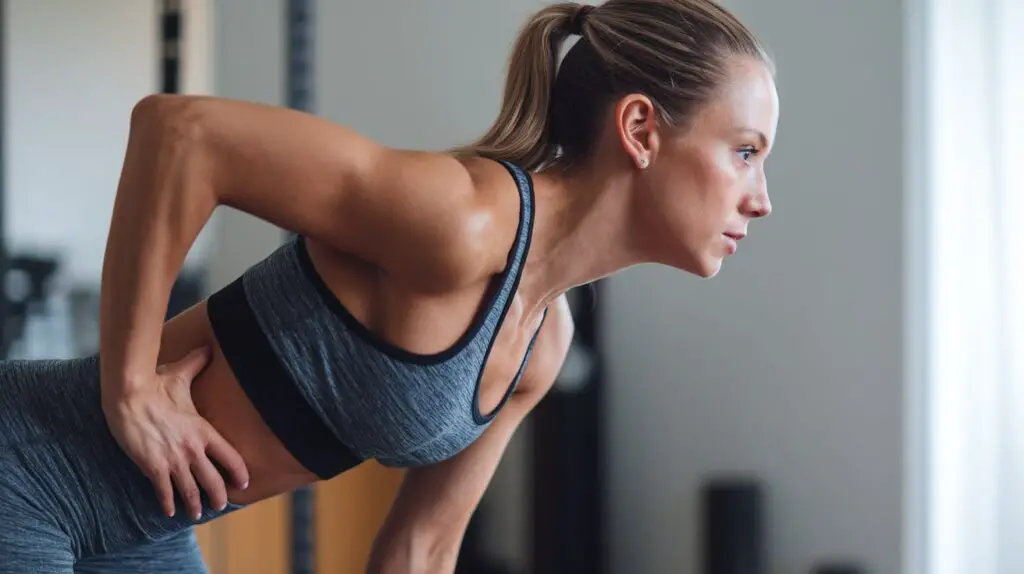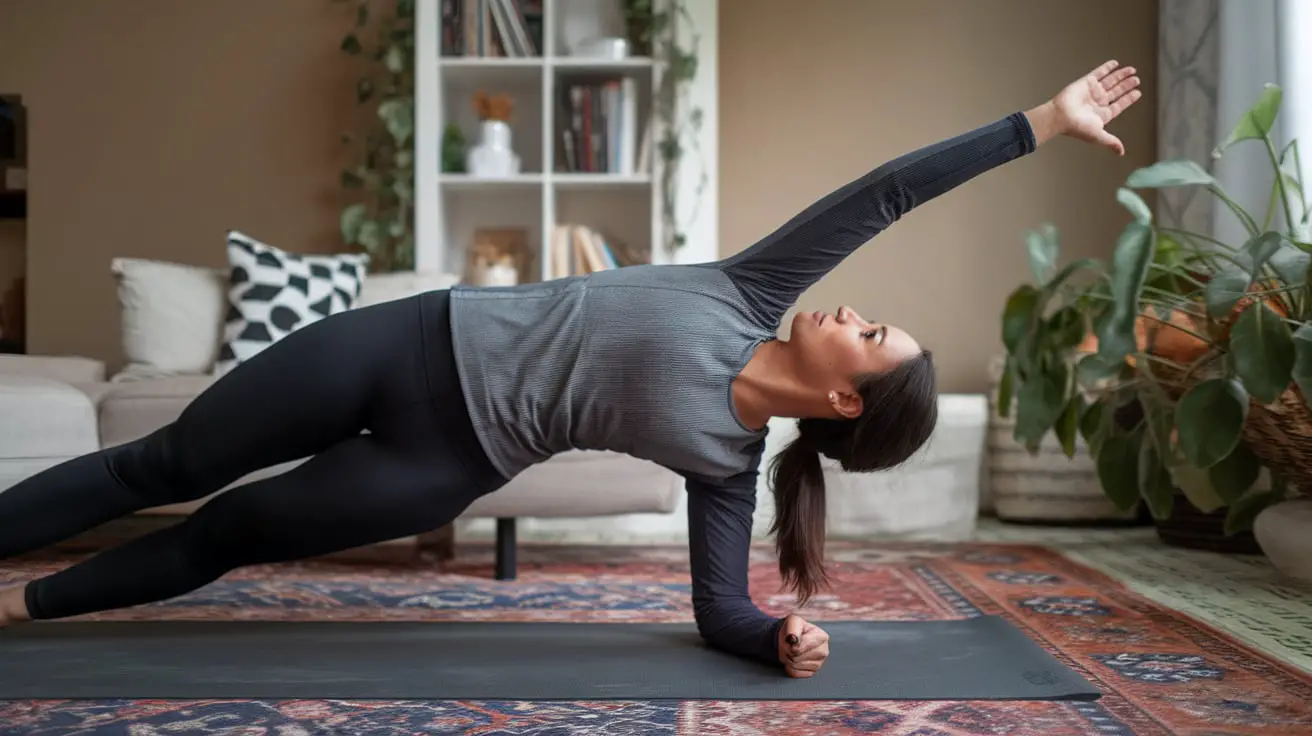Transforming your body doesn’t require expensive gym memberships or fancy equipment. A focused 25-minute workout at home can deliver remarkable results, targeting every major muscle group while boosting your cardiovascular health. This simple yet effective routine fits perfectly into busy schedules, making it ideal for women who want to stay fit without compromising their daily commitments.
The magic of this workout lies in its simplicity and efficiency. By combining strategic bodyweight exercises with precise timing, you’ll experience a complete fitness session that burns calories and builds strength. The carefully structured intervals maximize every minute, proving that short, focused workouts can be just as effective as longer gym sessions.
The following sections reveal a straightforward approach to full-body fitness that works for women of all fitness levels. Whether you’re new to exercise or already active, you’ll discover how to perform each movement correctly, manage your intensity, and optimize your results. Let’s explore how to transform your living room into a personal fitness studio and make every minute count.
What Makes This 25-Minute Workout Effective?

The effectiveness of a 25-minute workout stems from its scientific approach to exercise. High-Intensity Interval Training (HIIT) forms the foundation of this time-efficient routine, alternating between intense activity bursts and brief recovery periods. This method speeds up your metabolism and continues burning calories long after you finish exercising.
High-Intensity Interval Training Principles
Your body responds differently to short, intense bursts of exercise compared to steady-state workouts. HIIT triggers a response called excess post-exercise oxygen consumption (EPOC), which keeps your metabolism elevated for hours afterward. This explains why a focused 25-minute session can match or exceed the benefits of longer, moderate-intensity workouts.
Working at 85-95% of your maximum heart rate during intense intervals creates optimal conditions for fitness improvements. Here are the key principles that make HIIT so effective:
- Alternating intensity levels
- Short, powerful work periods
- Strategic recovery intervals
- Progressive overload potential
- Metabolic adaptation
Full Body Engagement Strategy
Moving multiple muscle groups simultaneously maximizes your workout efficiency. By combining exercises like squats with arm movements, you engage more muscles in less time. This comprehensive approach also improves functional strength, which helps in daily activities.
Rest and Work Intervals Explained
The magic ratio for this workout is 30 seconds of work followed by 15 seconds of rest. This timing allows you to maintain high intensity while preventing exhaustion. Your body needs these precise rest periods to replenish energy stores and prepare for the next intense interval.
Proper Form Fundamentals
Quality beats quantity in every exercise. Maintaining proper alignment protects your joints and targets the right muscles. For example, during push-ups, keep your core tight and body straight from head to heels. This attention to form prevents injuries and enhances results.
Energy Expenditure Optimization
Your body burns calories through three main pathways during this workout. First, the immediate energy used during exercises. Second, the oxygen debt that must be repaid post-workout. Third, the increased metabolic rate that persists for hours afterward.
The combination of compound movements and minimal rest keeps your heart rate elevated throughout the session. This sustained cardiovascular demand creates an optimal environment for fat burning while preserving muscle tissue.
Tracking your perceived exertion helps optimize energy output. On a scale of 1-10, aim for an 8-9 during work intervals and recover to a 5-6 during rest periods. This approach helps you maintain the right intensity without burning out too quickly.
Your breathing pattern plays a crucial role in energy management. Inhale during the easier portion of each movement and exhale during exertion. This synchronized breathing enhances oxygen delivery to working muscles and supports proper form.
How Should You Prepare for This Home Workout?

Preparing for your home workout requires minimal setup but thoughtful planning. A successful session starts with creating the right environment and getting your body ready for movement. Think of this preparation as laying the foundation for an effective workout that will keep you safe and motivated.
Space Requirements
Clear a space about 6 feet by 6 feet in your home. This area gives you enough room to move freely without restrictions. Remove any objects that might interfere with your movements, including furniture, toys, or decorative items. Your workout space needs these basic elements:
- Flat, non-slip surface
- Good ventilation
- Adequate lighting
- Room temperature setting
- Clear pathways for movement
Proper Workout Attire
Your exercise clothes should allow free movement while keeping you comfortable. A supportive sports bra, breathable top, and flexible bottoms work best. Avoid loose clothing that might get in your way during floor exercises.
The right footwear makes a significant difference in your workout quality. Athletic shoes with good grip help prevent slipping, though some exercises can be done barefoot on a yoga mat or carpet.
Hydration Guidelines
Start hydrating several hours before your workout. Your body needs water to regulate temperature and transport nutrients during exercise. A good hydration strategy improves performance and reduces the risk of dizziness or fatigue.
Drink 16-20 ounces of water two hours before exercising. Keep a water bottle nearby during your workout, taking small sips between exercise blocks. Pay attention to your body’s signals – if you feel thirsty, you’re already slightly dehydrated.
Pre-workout Warm-up Essentials
A proper warm-up activates your muscles and prepares your cardiovascular system. Start with gentle movements that gradually increase your heart rate and body temperature. Light marching in place, arm circles, and knee lifts wake up your muscles without straining them.
Dynamic stretches help improve your range of motion before the main workout. These movements should mimic the exercises you’ll perform during your session. Focus on moving your joints through their full range while maintaining control.
Safety Considerations
Check your surroundings for potential hazards. Make sure your exercise area has good airflow and keep a window open if possible. Place your water bottle where you won’t trip over it during movements.
Listen to your body throughout the preparation phase. If you notice any unusual pain or discomfort, modify your warm-up accordingly. Being aware of your physical limits helps prevent injuries and makes your workout more effective.
Your energy levels fluctuate throughout the day, so pick a time when you typically feel strong and alert. Morning workouts might suit some women better, while others might prefer afternoon sessions. The key is consistency in your chosen time slot.
A quick body scan before starting helps identify any areas that need extra attention during your warm-up. Note any muscle soreness or stiffness from previous activities and adjust your preparation accordingly.
Which Muscle Groups Will You Target?

Your muscles work as a connected network, supporting and strengthening each other through movement. This 25-minute workout targets specific muscle groups while creating a balanced, full-body effect. Understanding which muscles you’ll work helps you focus on proper form and maximize your results.
Upper Body Focus Areas
Your shoulders, chest, and arms receive special attention through bodyweight exercises. Push-ups strengthen your chest and triceps, while plank holds build shoulder stability. These movements create lean, defined arms without using weights:
- Push-up variations for chest and triceps
- Plank holds for shoulder strength
- Arm circles for mobility
- Diamond push-ups for definition
- Shoulder taps for stability
Core Strengthening Elements
A strong core supports every movement you make. The workout includes specific exercises that target your abdominal muscles, obliques, and lower back. Mountain climbers combine core engagement with cardio benefits, while hollow holds build deep core strength.
Your core muscles need different types of movement to develop fully. Static holds build endurance, while dynamic exercises improve functional strength. The combination of both creates a comprehensive approach to core development.
Lower Body Activation
Your legs contain the largest muscle groups in your body, making them crucial for calorie burning and overall strength. Squats and lunges target multiple muscles simultaneously, while calf raises add definition to your lower legs.
The workout includes variations of classic leg exercises to prevent boredom and challenge different muscle fibers. Each movement can be modified to match your fitness level while maintaining effectiveness.
Cardiovascular Components
Raising your heart rate burns calories and improves endurance. High-knee runs and jumping jacks integrate seamlessly between strength exercises, keeping your pulse elevated throughout the session.
These cardio bursts serve two purposes: they maintain an elevated heart rate and provide active recovery between strength movements. This combination optimizes both fat burning and muscle conditioning.
Full-body Integration Methods
Compound exercises work multiple muscle groups simultaneously, creating efficient, time-saving movements. Burpees combine a push-up, squat, and jump into one fluid motion, engaging your entire body.
The sequence of exercises matters. By alternating between upper and lower body movements, you keep working while allowing specific muscle groups to recover. This approach maintains intensity without exhausting any single area too quickly.
Your body learns to work as a unit through these integrated movements. The coordination required for these exercises improves balance, agility, and overall body awareness. Each session builds upon this foundation, creating lasting improvements in functional fitness.
The workout flows naturally from one movement to the next, reducing transition times and maintaining momentum. This continuous movement pattern keeps your heart rate elevated while working every major muscle group effectively.
What’s the Perfect Workout Structure?
A well-structured workout maximizes every minute of your 25-minute session. Breaking down your exercise routine into precise segments creates an efficient flow that delivers results while preventing burnout.
Exercise Timing Intervals
Your workout follows a specific pattern of work and rest periods. Each exercise lasts 45 seconds, followed by a 15-second transition period. This timing allows you to maintain proper form while challenging your muscles effectively. Here’s how your 25 minutes break down:
- 3-minute warm-up
- 20 minutes of timed intervals
- 2-minute cool-down sequence
- 30-second water breaks
- 15-second exercise transitions
Movement Transitions
Smooth transitions between exercises keep your heart rate elevated and save precious time. Moving from standing exercises to floor work requires practice, but becomes natural with repetition. Plan your exercise sequence to minimize position changes – group standing exercises together, then floor exercises.
Quick position adjustments maintain workout momentum. For example, after completing push-ups, roll directly into a plank position rather than standing up and getting back down.
Intensity Management
Your perceived effort should vary throughout the session. Start at 60% effort during the first round, gradually increasing to 80-90% by the final set. This progressive approach prevents early fatigue and allows you to complete all exercises with good form.
Monitor your breathing as a natural intensity gauge. If you can’t speak a short sentence, reduce your pace slightly. Conversely, if you can sing, increase your effort level.
Recovery Periods
Strategic rest prevents exhaustion while maintaining workout effectiveness. The 15-second breaks between exercises serve as active recovery – keep moving with light marching or gentle stretching rather than standing still.
Your body needs these brief pauses to reset form and prepare for the next movement. Use this time to check your posture and take quick sips of water when needed.
Form Modifications
Each exercise offers variations to match your fitness level. Push-ups can be performed on knees instead of toes, and squats can be less deep until strength improves. These adjustments maintain the exercise benefits while reducing injury risk.
Proper alignment matters more than speed or repetitions. Focus on controlled movements rather than rushing through exercises. This approach builds strength more effectively and reduces strain on your joints.
The workout structure adapts to your progress. As exercises become easier, add challenges like increased speed or more advanced variations. This flexibility keeps your routine challenging as your fitness improves.
Your workout pace should feel challenging but sustainable. If you notice your form declining significantly before the interval ends, switch to an easier variation for the remaining time.
How Can You Maximize Your Results?
Getting the most from your 25-minute workout requires attention to specific details that many women overlook. Small adjustments in your technique and habits can significantly boost your results without adding extra time to your routine.
Breathing Techniques
Your breath powers every movement. Synchronized breathing enhances oxygen delivery to your muscles and supports proper form. The basic pattern follows these key principles for maximum effectiveness:
- Exhale during exertion (pushing, lifting)
- Inhale during easier phases
- Steady rhythm throughout
- Deep belly breathing between sets
- Nose breathing during recovery
Proper Movement Execution
Quality trumps quantity in every exercise. Each movement should be controlled and purposeful, targeting the intended muscle groups. Start slowly to master the basic form before increasing speed.
The mind-muscle connection plays a crucial role in exercise effectiveness. Think about which muscles you’re working during each movement. This mental focus improves muscle activation and overall results.
Intensity Progression
Your body adapts quickly to exercise, so gradual progression keeps you improving. Week one might start with basic movements, while week two adds speed or complexity. This systematic approach prevents plateaus while reducing injury risk.
Track your progress using simple metrics like how many repetitions you complete in each 45-second interval. Small improvements add up to significant changes over time.
Recovery Optimization
Rest days are as important as workout days. Your muscles need time to repair and strengthen between sessions. Three workouts per week with a day of rest between each provides optimal recovery time.
Sleep quality directly affects your results. Seven to nine hours of sleep helps your body repair tissue and build strength. Poor sleep can negate the benefits of even the most perfect workout execution.
Post-workout Nutrition Timing
What you eat after exercising matters as much as the workout itself. Your muscles need protein and carbohydrates within 30 minutes after finishing your session. This timing window optimizes muscle recovery and energy replenishment.
A simple smoothie with protein powder and fruit provides quick nutrition. If you prefer whole foods, a combination of Greek yogurt and berries works well. The goal is fast-digesting nutrients that your body can use immediately.
Your hydration needs increase after intense exercise. Water helps transport nutrients to your muscles and removes waste products. Aim for 16-20 ounces of water in the hour following your workout.
Consistency in your post-workout routine creates a foundation for progress. Regular exercise combined with proper nutrition and recovery leads to lasting improvements in strength and fitness.
Transform Your Fitness Journey Today
A 25-minute home workout offers a practical solution for busy women who want to stay fit without complicated equipment or expensive gym memberships. By following the structured approach outlined above, focusing on proper form, and maintaining consistency, you’ll notice improvements in strength, energy levels, and overall fitness. The combination of strategic exercise timing, proper breathing, and attention to post-workout nutrition creates a complete fitness system that fits into any schedule.
Your fitness journey becomes more effective when you pay attention to the details – from preparing your workout space to executing each movement with purpose. The beauty of this workout lies in its simplicity and adaptability, allowing you to progress at your own pace while building a stronger, more capable body. Start with the basics, focus on proper form, and gradually increase intensity as you become stronger. Your dedication to these principles will lead to lasting results that extend beyond physical changes, improving your daily life activities and overall well-being.
Frequently Asked Questions
Q: How much space do I need for this 25-minute workout?
A: You need approximately 6 feet by 6 feet of clear space with a flat, non-slip surface and good ventilation.
Q: What’s the ideal work-to-rest ratio for each exercise?
A: Each exercise lasts 45 seconds, followed by a 15-second transition period, maintaining an effective balance between effort and recovery.
Q: Do I need to wear specific workout clothes?
A: Yes, wear a supportive sports bra, breathable top, and flexible bottoms. Athletic shoes with good grip are recommended, though some exercises can be done barefoot.
Q: How much water should I drink before the workout?
A: Drink 16-20 ounces of water two hours before exercising, and keep a water bottle nearby for small sips between exercise blocks.
Q: What’s the best time to eat after completing the workout?
A: Consume protein and carbohydrates within 30 minutes after finishing your session for optimal muscle recovery and energy replenishment.
Q: How many times per week should I do this workout?
A: Three workouts per week with a day of rest between each session provides optimal results while allowing proper recovery time.
Q: How do I know if I’m working at the right intensity?
A: Start at 60% effort during the first round, gradually increasing to 80-90% by the final set. If you can’t speak a short sentence, reduce your pace slightly.
Q: What should I do during the 15-second breaks?
A: Keep moving with light marching or gentle stretching rather than standing still, using this time to check your posture and take quick sips of water.

